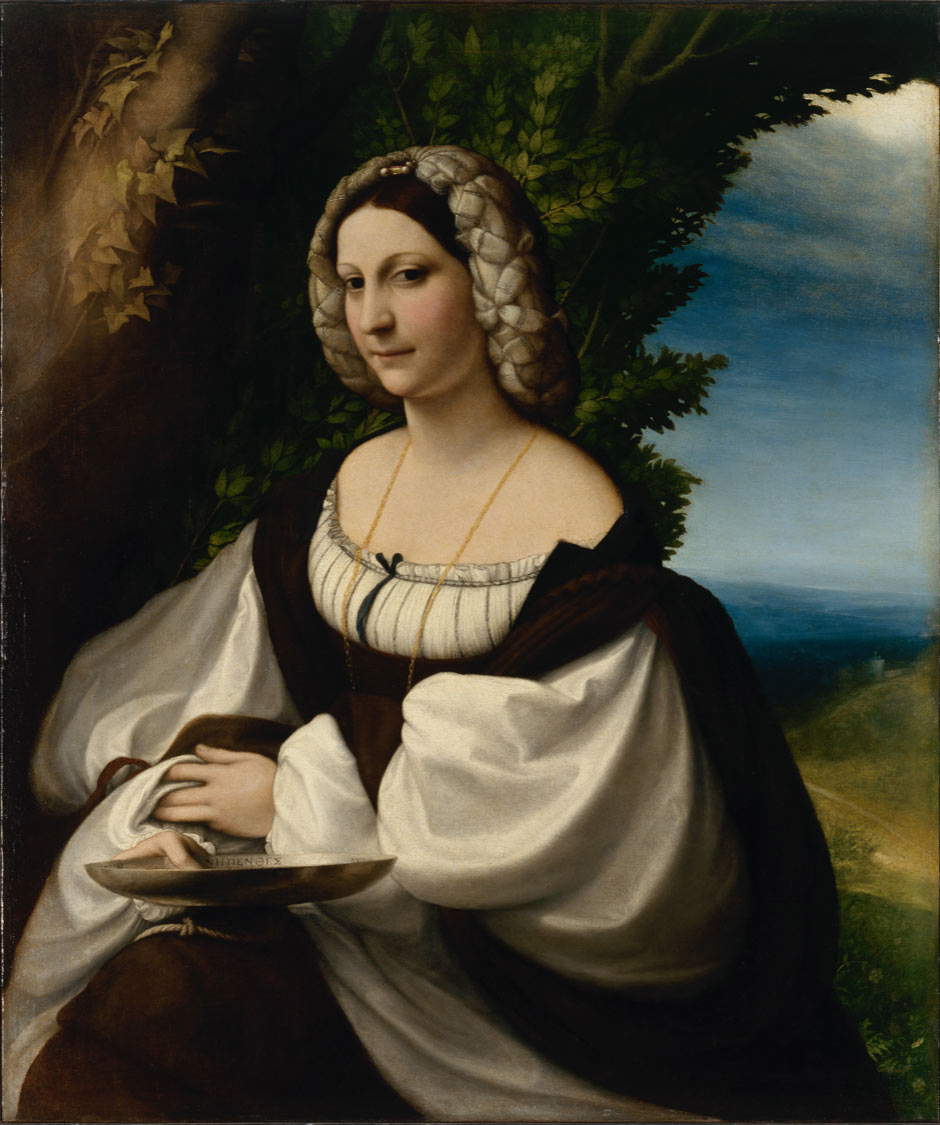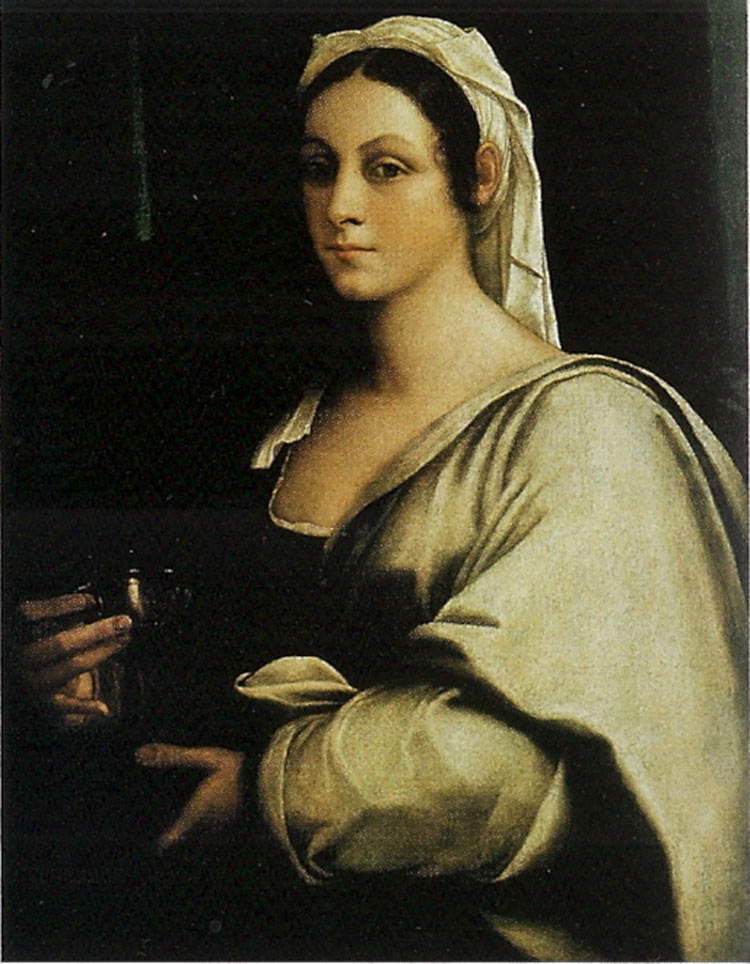The Countess of Correggio
Glimpse of sky over Reggio Emilia with the arrival of the Portrait of a Gentlewoman from the Hermitage Museum in St. Petersburg, and what a sky! It is the only large and luminous portrait executed by Correggio that comes to engulf the city at the moment when it participates, by ministerial decree, in the national highlight of Parma, capital of culture. It is scarcely worth mentioning that Parma owes its universal glory to Correggio’s transfiguring fresco cycles, and that Antonio Allegri brought himself there from the land of Reggio Emilia, and precisely from the native place from which he took his artistic name, later celebrated throughout the world.
An event that realizes that kind of single-subject exhibition vague by Umberto Eco who well knew how a single jewel of art could call, evoke and scatter a multitude of values, and thus involve that visitor not limited to the enjoyment of the albeit talented surface of the visible data, but who would be fulfilled by the contextual universe of the subject. This is the case in Reggio today, although a strange committee has preferred the almost bathing title of Young Woman, which is rather inaccurate but was perhaps chosen hoping for a more advertising-driven influx. We must say that having distorted the title that appears in any serious catalog also leads to a pre-emptive distortion of popular expectation and the subsequent meeting, as well as to the perplexity of scholars. Even the accompaniment to the Exhibition is not succulently didactic and makes one transit through uncertainties.
But the radiant presence of the Lady, appearing in an exhilarating pictorial blaze, makes one forget organizational abrasions and renders full happiness to everyone who approaches it. By the unanimous consensus of critics, the execution of this masterpiece is placed in the winter between 1520 and 1521, immediately after the titanic fresco execution of the dome of San Giovanni Evangelista in Parma, that miracol d’arte sanza exemplo, where Correggio totally abstracts from the load-bearing architecture, opens the heavens to infinity, reaches and surpasses Michelangelo in the mighty, suspended bodies of the Apostles, and lets Christ descend freely from the empyrean. Such a dome revives the Renaissance and offers pasture for the coming centuries; for its author it is the achievement of doing great, which from now on will be his seal. Therefore, the Gentlewoman of St. Petersburg is its translation into an early and very singular easel work: a hà pax of the entire intellectual painting of the Renaissance. The imminent placement of the Lady on the visual picture and the airy unfolding of her dress welcomes us with a true embrace of generous amplitude.
 |
| Antonio Allegri known as Correggio (Correggio, 1489 - ivi 1534), Portrait of a Gentlewoman; oil on canvas, 103 x 87.5 cm; St. Petersburg, Hermitage. It bears the signature ANTON LAET (Antonius Laetus) at the level of the effigy’s face. |
Allegri always remained a citizen of Correggio, the seat of a fief of imperial investiture, protected by local counts. In October 1520 he came down from the scaffolding of San Giovanni and returned home very happy in core, as he came to marry his beautiful 17-year-old Jeronima, who nine months later would give him a baby boy, Pomponio. He remains five months in his homeland and here he finds the ferment of the Court over the announced arrival of an official diploma from Charles V, which arrives punctually on December 16. Countess Veronica GÃ mbara, widowed by Giberto X, had asked for the recognition of her two sons as direct heirs of the fief and so she obtained it, along with her appointment as Regent of the State: a new fact in the political and heraldic sphere of the Empire, and we would say an early sign of female emancipation. But great were the prestige and fascination Veronica had already spread of herself among the Italian courts as a lofty poetess, and she had had direct talks and correspondence at the highest levels: with the Popes, the King of France and the young Charles V, who soon sent her a new letter of special protection. We must not forget the social standing of GÃ mbara, who was sister, aunt and mother of as many Cardinals and who hosted Charles V in Bologna on the occasion of his coronation.
The winter of 1520 was therefore the time when she requested from her beloved painter, her subject, a solemn portrait to be placed in the Reception Hall of the new Palace that the da Correggio had had designed by Biagio Rossetti and adorned with a Portal that is the most beautiful in all of northern Italy in the Renaissance, including Venice. The most attentive critics strongly emphasize the exceptional size of this portrait in the period: such that they rule out the possibility that it was a transport piece, or of premarital, or amorous destination. A palatial portrait, then, for which the Countess and the ingenious Antonio studied every detail, and a most attentive posture: a portrait with hands where the point of view is on the hands (the fatality) and where the progress of our gaze in height is accompanied by the slight arc, concave and gradient, of the subt’in up to the light, perfect neck and face, bathed in the same meridian light that makes the ebony turn of the shoulders shine. With her body the Dame turns to her right mind the face turns slightly toward us; the tight and strong-willed, yet gentle, stretch of the mouth is accompanied by the intense gaze that descends to the opposite and balances the frontal and in-plane chiasmus of the entire bodily figure. This vital charge conveys all the characterful and intellectual energy of the Countess, now Head of State.
Masterful is the rhythm of the gown (here is the great doing) with the wide undulations of the sleeves and and draped falls, so that all the converging whites to the hands are concentrated in the striking silver bowl with the spherical foot that bears in the interior the Greek word NEPENTES (an ancient drug, mentioned in Homer’s Odyssey) alluding to her detachment from the pain of widowhood and the cordiality with which she may receive the distinguished guests. She will rule the state on behalf of the younger children and will not remarry, as the cingulum castitatis, with her one knot ensures. But a supreme sign of honor Ella desires: the poetic coronation that all surrounds her head, enriched by the intricate and perfect capigliara, whose knots are the symbol of thoughts. And Correggio, burning with admiration, gaily spreads behind her the radiant branches of the poetic laurel, aonian and Apollonian. GÃ mbara was highly esteemed by Pietro Bembo and with him built the national language; she was admired by Ariosto, who sang and visited her in Correggio; she was accompanied in her poetic quest by Vittoria Colonna, the inspirer of Michelangelo, with whom she was always in intense connection. Vittoria then had an effigy executed exemplifying that of her friend.
 |
| Sebastiano del Piombo, Portrait of Vittoria Colonna (post 1525). |
Beside Veronica’s face stands a trunk-unusual apparition in a portrait, moreover female-and it is the symbol of the lineage into which she entered as a bride and to which, like obvious ivy, she binds herself. Here Ella wants the dear painter’s signature. Stunning are the background and landscape: the sky has thrilled exegetes, who have much admired the celestial dome in other Allegrian paintings and here find a superb pictorial expanse of blues. The sky is the story of the Countess’s life: on the horizon the onset of youth, then the fullness of marriage, and just beyond the gray cloud of the loss of her beloved spouse, but above the fullest light, the burst of the heartfelt whiteness of the new phase of life. On the lawn, beside her, the veronicas flowers, the gentle forget-me-nots.
The coming of this painting to Reggio Emilia stands between the end of the Leonardian year and the present new year, splendidly rich in historical evocations. Truly this arrival opens wide the fascinating panorama of the Reggio Emilia Renaissance, so important across the board with its Courts of Scandiano, Correggio and Novellara, which gave to Italian civilization on the literary and theatrical levels Nicolò da Correggio (Leonardo’s friend and director), Maria Matteo Boiardo, Ludovico Ariosto, the Gà mbara itself; on the architectural level the works of Cesare Cesariano, Biagio Rossetti, Giulio Romano; on the arts level the sculpture of Bartolomeo Spani, and the painting of Correggio and Lelio Orsi. Reggio, which already in the sixteenth century was the favorite city of the Este Duke Ercole I, became in that century a city of noble palaces and churches, and came to host none other than the very famous Notte, the masterpiece of masterpieces of the new painting, with which Correggio by Vasari had the title of divine and the supreme comparison: hold for certain that no one ever touched colors as he did.
Warning: the translation into English of the original Italian article was created using automatic tools. We undertake to review all articles, but we do not guarantee the total absence of inaccuracies in the translation due to the program. You can find the original by clicking on the ITA button. If you find any mistake,please contact us.




























